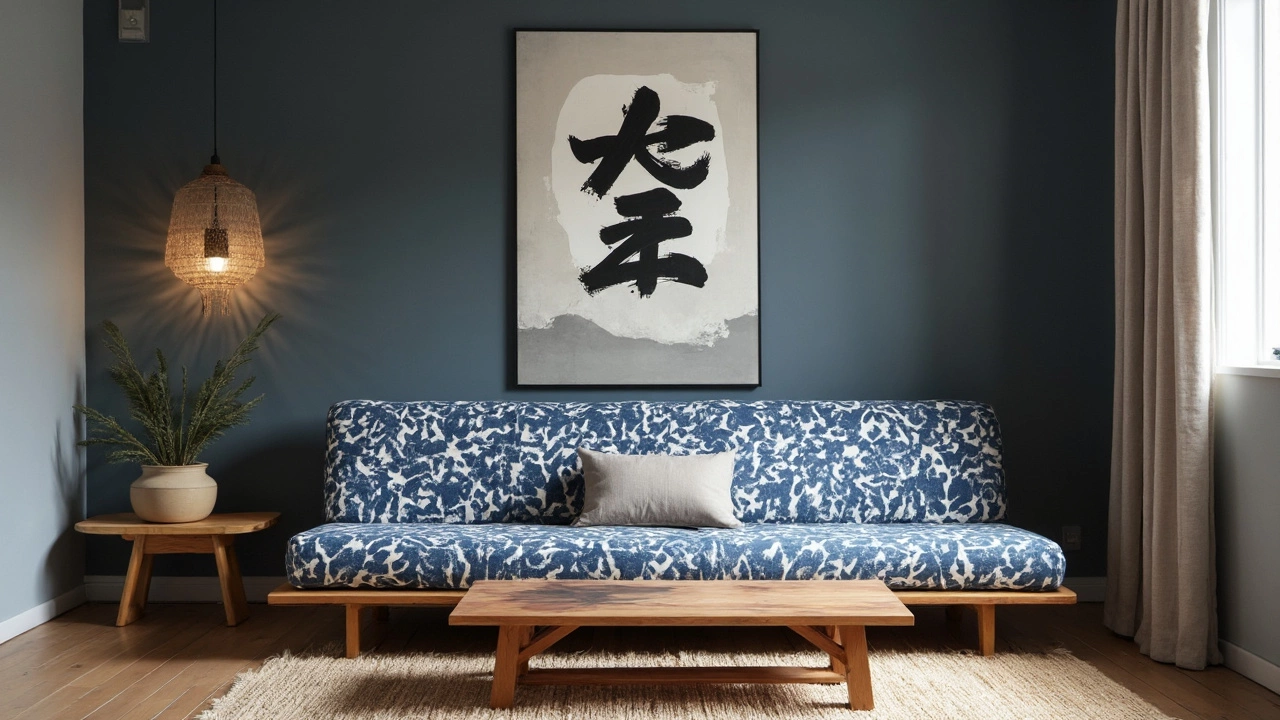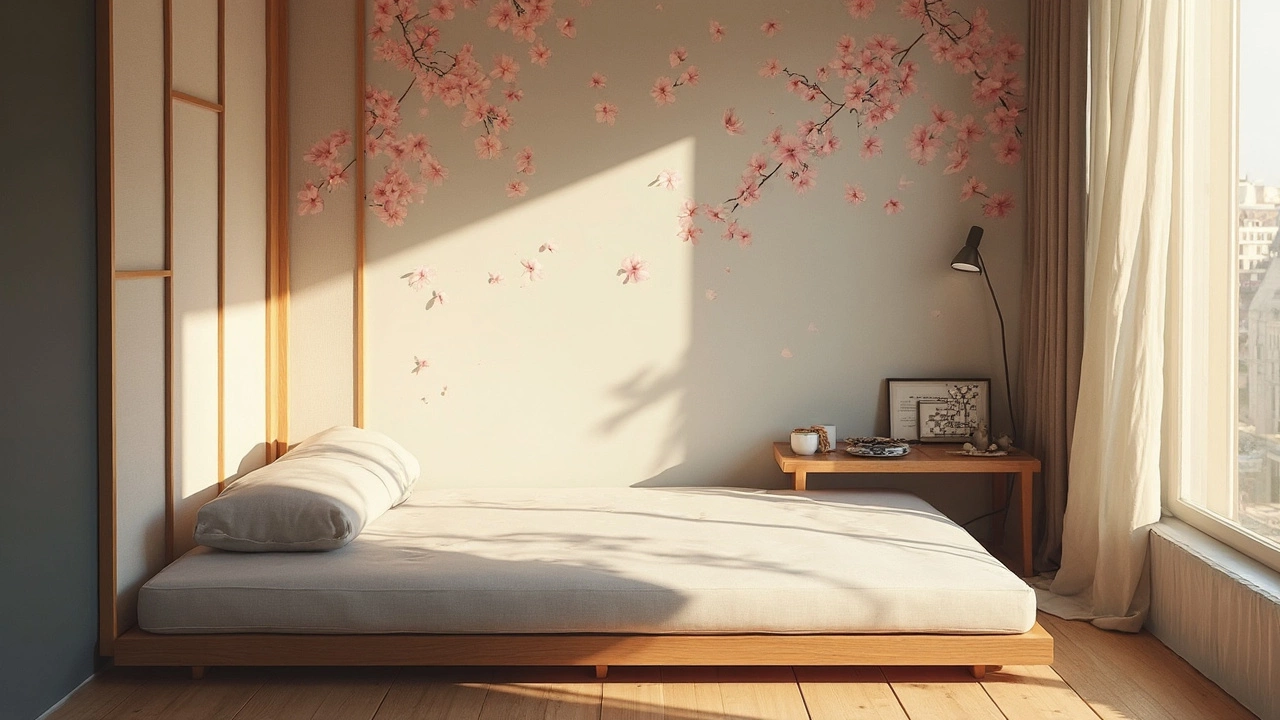Ever tried sleeping on a bed that could just disappear by day? That's what Japanese bedding, especially futons, is all about. Unlike your average bulky mattress, a futon is a sleek, flexible, and downright cool option for those tight on space or wanting a minimalist vibe. Spread it out at night for a comfy sleep, then roll it up in the morning—easy peasy!
Futons aren't just a sleeping setup; they can redefine how your home feels and functions. Imagine flipping your sleep zone into a lounge area in minutes. That's versatility at its best. Plus, these are optimal for urban living where square footage is a luxury. If you’ve ever thought about how to make the best of small spaces, Japanese futons need to be on your radar.
- Introduction to Japanese Bedding
- Futons versus Western Mattresses
- Futons in Modern Home Decor
- Choosing the Right Futon for Your Space
- Caring for Your Japanese Bedding
Introduction to Japanese Bedding
When we talk about Japanese bedding, it's all about simplicity and efficiency. The standout star here is the futon, which differs quite a bit from Western bedding. It's a thin mattress placed directly on a tatami mat. This setup isn't just a nod to minimalism but is deeply rooted in culture and tradition.
Historically, Japanese homes were designed to maximize every inch. Traditional housing often included rooms known as washitsu, with tatami floors, making it perfect for futon usage. It’s a way of life, really, where each room is multi-functional and there's no need for a separate bed frame.
Features of Japanese Bedding
Futons are famous for their portability and ease of storage. The futon set typically includes the shikibuton (the mattress), the kakebuton (the comforter), and pillows. All these components can be folded and stashed away during the day, freeing up space. It’s incredibly handy for those of us living in apartment spaces or small homes.
But it's not all about saving space. Japanese bedding is also quite ergonomic, promoting natural spine alignment due to its firm surface. This might take some getting used to if you’re accustomed to soft, plush mattresses.
The Modern Adaptation
Today, the concept of Japanese bedding has traveled far beyond its origins, influencing designs worldwide. Modern futons come with upgraded materials, offering a blend of traditional and contemporary comfort. They’re not just for the bedroom anymore; many people use futon sofas in living rooms, enhancing both style and function.
If you’re keen on blending traditional home aesthetics with modern practicality, a Japanese-style futon could be a pretty solid choice. They bring a refreshing, minimalistic charm while also being a cultural icon. That’s a two-for-one deal you don’t want to miss out on!
Futons versus Western Mattresses
When it comes to choosing between Japanese bedding and the more familiar Western mattresses, there's quite a bit to consider. Let's break it down to see what makes each one unique and ideal for different lifestyles.
Comfort and Support
Futons are typically thinner and firmer compared to Western mattresses. They're designed to lay directly on the floor or on a low frame, providing a level of firmness that's appreciated by those who prefer strong back support. In contrast, Western mattresses often come with layers of cushioning on box springs or frames, offering a softer feel that's great for those who love to sink into bed.
Space and Versatility
If you're short on space or love keeping things minimalist, futons have the upper hand. They're super easy to roll up and stash away during the day, freeing up room for other activities. Western mattresses, on the other hand, are bulky and require a dedicated space in your bedroom. This can limit how you use your space, especially in a small apartment.
Maintenance and Longevity
Futons generally need more frequent airing out and occasional sunlight exposure to prevent moisture buildup, but they're quite durable. In contrast, Western mattresses tend to have a longer lifespan with less daily maintenance, though they do require rotation and eventually replacement after about 7-10 years.
Cost Factor
Cost is another significant factor. Futons are usually more affordable, not to mention they cut out the need for additional furniture like bed frames and box springs. A good quality Western mattress, especially those top-of-the-line memory foam or spring versions, can get pricey—often with hidden extra costs for accessories.
A Cultural Experience
For those interested in adopting a cultural aspect into their everyday lives, switching to a futon offers a touch of Japan's minimalist living style right at home. It brings a unique cultural charm that a standard Western mattress just doesn't deliver.
Choosing between a futon and a Western mattress comes down to your lifestyle, space, and personal preference. Each has its pros and cons, but understanding them helps you make the best choice for your home and comfort needs.

Futons in Modern Home Decor
Who said futons were just for sleeping? Today's Japanese bedding can transform how you think about your living spaces, making them sleek and multifunctional. In an era where sofa beds are kings of versatility, incorporating a futon into your decor can add both style and practicality.
Futons have a unique ability to blend seamlessly into various design themes—from minimalist to boho to even the more eclectic styles you see today. They are often favored in urban apartments where space-saving is key. What’s truly fascinating is how these futons act as both a statement piece and a functional item. They can be a bed by night and a plush lounger by day.
Benefits of Futons in Compact Living Spaces
For city folks, the futon can be a lifesaver. You don't have to deal with the cost or hassle of a traditional bed and mattress, and you get your space back in the morning. They're easy to tuck away, especially if you snag one with a cover that matches the rest of your pad. Plus, the aesthetic is minimalist and chic—perfect if you're channeling a zen-like home environment.
Design Aspects
Material matters a lot when you’re picking a futon for modern decor. Look for breathable materials like cotton or blends for comfort and durability. Futon covers come in an array of colors and patterns. Feel like changing it up? Just switch the cover, and it’s like you have a new piece of furniture.
How to Make the Most of Your Futon
Hey, if you’re thinking of swapping out your old, clunky furniture for something more adaptable, consider these tips:
- Mix and match your futon with throw pillows or a cozy blanket to add a personal touch and warmth.
- A transparent coffee table can help maintain an open feel in the room while fitting your futon seamlessly.
- Choose a low-profile platform bed frame if you occasionally use the futon as a bed. It’ll keep your space feeling airy.
Got friends or family popping over? No stress, pop your futon into the lounger position, and you're all set. This little piece of Japanese innovation lets you redefine and reclaim your living space with style.
Choosing the Right Futon for Your Space
So, you're ready to bring some Japanese bedding magic into your home, but how do you pick the perfect futon? It’s not just about looks—functionality is key. Here’s a straightforward guide to help you choose the right fit for your lifestyle.
Consider the Space
First up, assess the area where you plan to lay your futon. Measure the dimensions to ensure you’re not squeezing it into a too-tight space. Remember, the beauty of a futon lies in its flexibility. It should fit neatly as both a bed and a roll-up during the day.
Opt for Quality Materials
Not all futons are created equal. Look for ones made from high-quality cotton or wool for durability and comfort. These materials not only offer better support but also tend to last longer.
Check the Thickness
Futon thickness is a game-changer. A thicker futon can provide better cushioning for those used to softer Western beds. If you're looking for firm support, a thinner option might suit your needs. It’s all about your comfort preference.
Customization Options
Did you know some futons come with customization options? Choose from different patterns and colors to match your decor. Keep your style unique, yet cozy.
Here’s a quick tip: If you’re combining your futon with a sofa bed, ensure it complements or contrasts nicely with your existing decor. They should enhance the room, not clash with it.
Budget
Lastly, let’s talk dollars. While futons can be an economical choice compared to traditional sofa beds, don’t skimp on quality. A few extra bucks can be the difference between a temporary fix and a long-term piece of comfort furniture.
| Futon Feature | Consideration |
|---|---|
| Space | Measure dimensions for fit |
| Material | Choose high-quality cotton or wool |
| Thickness | Depends on comfort preference |
| Customization | Opt for style that matches your decor |
With these tips, you’re armed and ready to pick a futon that not only looks good but also feels great. Happy shopping!

Caring for Your Japanese Bedding
Taking care of your Japanese bedding isn't just about tidying up; it's about ensuring your futon stays cozy and lasts as long as possible. The good news? It’s not too complicated! With a few practices, you can keep your futon fresh and inviting every time you unroll it.
Regular Airing and Sun Exposure
Your futon loves the sun! To keep things dry and fluffy, it's important to hang your futon outside regularly on a bright, non-humid day. Sunlight naturally dehumidifies and keeps pesky odors at bay. Plus, UV rays help eliminate dust mites, which is great for people with allergies.
Fluffing and Maintenance
Give your futon a little love by regularly fluffing it. Think of it like plumping up a pillow. It keeps the cotton filling from clumping and helps maintain its shape. If your futon starts to get thin or lumpy, consider buying a futon clip or beater to give it a good shake.
Storing Your Futon
When it’s not in use, store your futon properly. Use breathable storage bags to avoid any moisture buildup. Don’t just stash it in a dark closet; find a space where there’s good airflow. Remember, a musty futon is nobody’s friend.
Cleaning Tips
Spot clean any spills or stains immediately with a damp cloth to prevent them from setting. For a deeper clean, check if the futon cover is removable and machine washable. If not, gentle hand washing with mild soap may be your best bet.
Dealing with Odors
If odors persist, sprinkle a little baking soda on the surface, let it sit for 30 minutes, and then vacuum. This trick works wonders for freshening things up naturally!
| Action | Frequency |
|---|---|
| Sun exposure | Weekly |
| Fluffing | Every other day |
| Storage check | Monthly |
By keeping up with these simple care tips, your Japanese bedding will continue to offer the inviting comfort you love. And who doesn’t want a bed that feels just as fresh as it looks?





